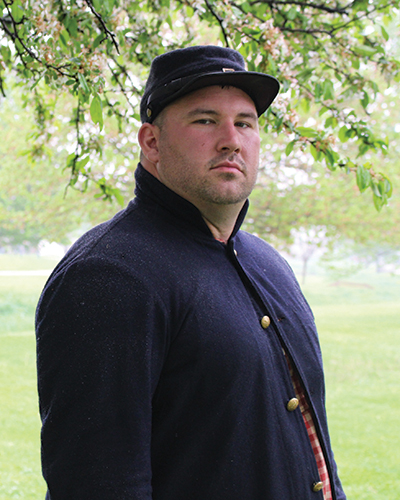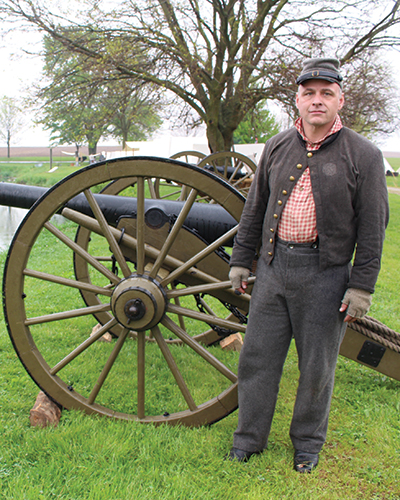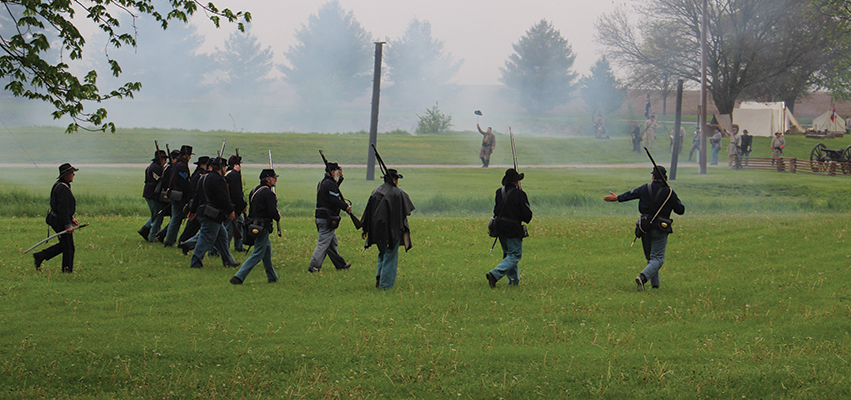“The world will little note, nor long remember what we say here, but it can never forget what they did here.” —President Abraham Lincoln, Gettysburg Address
Two hundred American flags lined Route 122 from I-155 to Veterans’ Memorial Park on the last weekend of April, setting a patriotic tone for Delavan’s annual Civil War Days event. Each year, the park hosts period demonstrations, historical impersonators and full-scale battles, and for three days, this sleepy Tazewell County town exists in another time and place—the kickoff to a full season of reenactment events around the region.
“We live our regular lives, we pay our bills, we go to work, we come home, we take care of our chores—but when you go to a Civil War reenactment weekend, you’re in a different era,” says Alex Timmerman, commander of the 9th Regiment Illinois Volunteer Cavalry, and organizer of the Delavan event. “You’re living differently, you’re cooking differently, you’re sleeping differently—or not at all, typically.” He chuckles, standing outside his unit’s encampment—a gathering of burlap wedge tents, simple A-frame shelters lining the small town’s creek—where they’ll spend the weekend cooking over fire and sleeping outside.
Around the park, Timmerman and his team have arranged 600 landscaping timbers to look like split-rail fencing—“something to fight behind for battles.” Nearby, sutlers peddle provisions to soldiers; a body is being embalmed at the 17th Corps Field Hospital tent; and women are chatting in hoop skirts and mantles, toting parasols. Amidst the drizzling rain, General Ulysses S. Grant just walked by.
A fog rises over the field, masking signs of the modern day: electric wires and poles, cars and road signs. It’s not hard to pretend it’s 1860-something. But to really be there, to relive the Civil War, you need to play the part.
 History Lessons
History Lessons
Water and wool don’t mix well, but the ensuing discomfort develops character. Bob Killion, Curator of Collection and Technology at the Peoria Historical Society by day, dons a soaking-wet Confederate uniform, standing in front of the cannon that ended Sunday’s battle early when it misfired and became a safety concern. The reenactors are portraying the battle known as Hornet’s Nest at Shiloh, the setting for some of the war’s most vicious fighting.
Killion got pulled into the hobby a few years back by close friends who’ve spent their lives playing war, but it wasn’t a hard sell. Since then, his collection has grown from a single black powder pistol and a cheap replica uniform to 10 black powder rifles (including two originals), 10 black powder pistols, a cache of swords and bayonets, and a complete set of enlisted uniforms, Union and Confederate. He’s a history buff and he’s not coy about it.
“The two most common rifles are the Enfield rifle and the 1861 Springfield rifle, and I have both of those. But the Springfield rifle was captured at Harper’s Ferry by the Confederates [In 1861, the Confederacy captured the Union-held town, seizing control of the national armory and its arms-making machinery.], so they made what’s called the Richmond rifle, which is almost the same thing… I just have lots of different variations, and the same thing with pistols,” Killion says, delivering a history lesson in a single breath.
Last year, Killion participated in the sesquicentennial of the Battle of Franklin, Tennessee, where he met an expert to authenticate his weapons. “He took off every marking that wouldn’t have been on them during the Civil War, and added every marking that would have.” Aside from the barrel, which is thinner than most modern rifles, “you wouldn’t know it’s not an original,” he says. And that’s just the start.
The Reenactment Continuum
Killion’s unit, which typically portrays Company K of the 8th Louisiana Infantry Regiment (“because there are never enough Confederates in the Midwest”) is a gathering of progressives, “people who want to be as accurate as possible, but are more about understanding and teaching,“ he explains. “The idea is that you should always be trying to update your equipment and trying to be more authentic. And we’re doing research on our unit all the time.”
Further down the scale are reenactors who don’t care as much about accuracy. “They’ll put together an outfit, and they’re not doing necessarily any particular [battle] impression,” he explains, but that’s rare. As progressives, Killion and his crew pore over original source materials—like soldiers’ letters and official requisitions—looking for clues, piecing together history like detectives on a cold case.
 They recently discovered, for instance, that their unit never once requested replacement cartridge box straps, meaning the soldiers must have been carrying their cartridge boxes another way. During battles, the men now wear it on an alternative belt. “Most people wouldn’t know we were wrong,” Killion explains, “but we figured out this is the way our guys did it.” And this attention to detail makes it all the more real.
They recently discovered, for instance, that their unit never once requested replacement cartridge box straps, meaning the soldiers must have been carrying their cartridge boxes another way. During battles, the men now wear it on an alternative belt. “Most people wouldn’t know we were wrong,” Killion explains, “but we figured out this is the way our guys did it.” And this attention to detail makes it all the more real.
On the other end of the spectrum are the elitists. “Some hardcore people in units don’t even perform for the public,” he says. “They’ll do private events in the woods and try to be immersed in the whole experience.” That usually means staying in first-person. Killion, however, doesn’t mind breaking character.
“When people talk to me, I don’t act like it’s 1863,” he laughs. “We will explain what we’re wearing and why.”
Regardless of style and approach, everyone shares one thing: a love for history, says Timmerman. “You experience firsthand what you’re reading about.”
Taste of Black Powder
This hobby is not cheap. It takes most new recruits a few years to buy their gear in order to spread out the costs—$2,000 to $3,500 for the weapon, equipment and uniform, for starters—but other hobbyists can help ease the transition. “I have a large amount of loaner gear,” Timmerman says, so if someone wants to join… I’ll set them up with a uniform and equipment for the weekend, and they can try it out.”
It’s not exactly a relaxing pastime either, he explains, but a working hobby. “You have to work to set up your stuff, to transport it, to take it down… and drills can be a pain in the butt.” (Before battles, Timmerman runs his men through a series of military-style, warm-up workouts.) Still, people get hooked easily. “Nine out of 10 people who try it stay with it,” he says.
“The cool thing about it—for both the participant and for the people who are watching—is that you get a sense of history that you don’t get from reading a book, or even watching a film,” Killion adds. “It makes history come alive, and it gets people excited.”
Of course, there are rules. After all, everyone’s using real weapons.
“The only thing that’s missing is the projectile,” Timmerman explains. The general rule is to elevate the gun 35 degrees if you’re beyond 40 yards out—more if you’re closer—and if you’re super-close, you don’t shoot at all. “It’s essentially a flamethrower,” he notes. “People have been burned by these [guns], and it gets pretty nasty if you do.” There are medics on site, just in case, but nearly all reenactors use genuine firearms: it authenticates the experience.
“Just the smells!” Killion exclaims. “We’re loading just like they really were, so you’re ripping a paper cartridge with your teeth and pouring the powder down the barrel. You taste black powder and you get grimy.
“We know that it’s not real,” he adds, “yet your adrenaline gets up when people fall down around you, and people are charging you with bayonets. All this… gives you a much greater sense of what it was like to be a soldier during that time period than anything else you could possibly do.”
 The Next Chapter
The Next Chapter
You could participate in a reenactment every weekend if you wanted to, Timmerman says. “It consumes a lot of time because when you get into it, you want to do more, and there’s always more. Then there are different impressions: do you want to do a Confederate… or a Union infantry impression, or do you want to do a specific time of the war? And your collection gets bigger and bigger.”
On average, Timmerman’s unit participates in two or three Civil War events a month, statewide or regionally, and one national event each year. But it’s not just the Civil War that’s being relived locally.
“You can literally reenact anything: Roman legionaries, Vikings, the War of 1812. Whatever you can think of, there’s probably somebody doing it,” Killion says. World War II battles, in particular, are growing in popularity, he adds. Still, there’s something about the Civil War—the war that pitted our country against itself—which resonates with people.
“For one thing, anybody whose family has been here since that time period probably has an ancestor who was on one side or the other,” he explains. “It’s one of those exciting chapters in our history. Also, I think it’s something that’s just been part of our national psyche.”
“We want people to get a better understanding of what these guys went through,” adds Timmerman.
It’s a walk through history that offers an escape from the present—a welcome way to unplug from the daily grind—and an old-fashioned salute to fellowship and camaraderie. “You’re out there around the campfire on a Saturday night, enjoying everybody’s company, and you’re wearing a Civil War uniform and using Civil War-replica items to live. It’s like the real world doesn’t exist.” a&s


